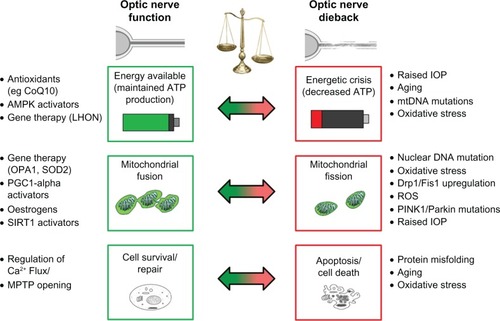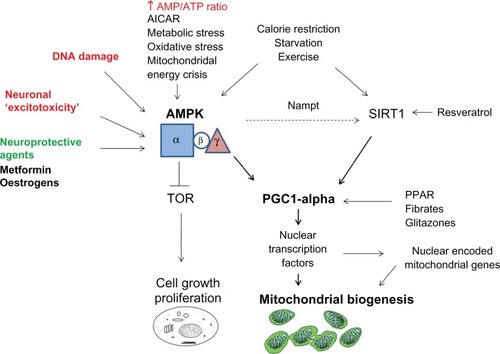Figures & data
Table 1 Mitochondrial diseases with ocular involvement
Figure 1 Factors contributing to optic nerve degeneration.
Note: The spectrum of mitochondrial dysfunction in the eye has emerged through understanding of the contribution of multiple stressors leading to mitochondrial failure and optic nerve loss. While controversy continues as to whether mitochondrial impairment in these diseases is primary or secondary to upstream disease pathways, the mitochondrion is emerging as a central culprit in cell death. Therapeutic developments aimed at boosting mitochondrial function are gathering pace. These approaches are likely to be of benefit not only in retinal disease, but also in diseases of the aging brain due to the growing evidence for a role of mitochondrial decline in age-related neurodegeneration.

Figure 2 Role of AMPK in neuroprotection.
Note: AMP-Activated protein kinase (AMPK) is a heterotrimic enzyme that activates catabolic pathways and turns off anabolic pathways in response to increased AMP/ATP ratio (hypoxia,glucose deprivation, OXPHOS inhibition), Ca2+ mediated neuronal excitotoxicity, DNA damage. Low ATP levels activate AMPK by phosphorylation of AMPK at Thr172 in the kinase domain (in the alpha subunit). Once activated, AMPK inhibits ATP consumption, inhibits protein synthesis (by inhibiting Target of Rapamycin, TOR), and inhibits fatty acid and cholesterol synthesis. AMPK can drive mitochondrial biogenesis by phosphorylation of mitochondrial transcriptional coregulators including PGC-1a; and indirectly promote SIRT1 activity via regeneration of NAD+ through the enzyme Nampt. Emerging neuroprotective avenues for AMPK activation act via increasing AMP/ATP ratio (Glitazones), Metformin, and Estradiol.
